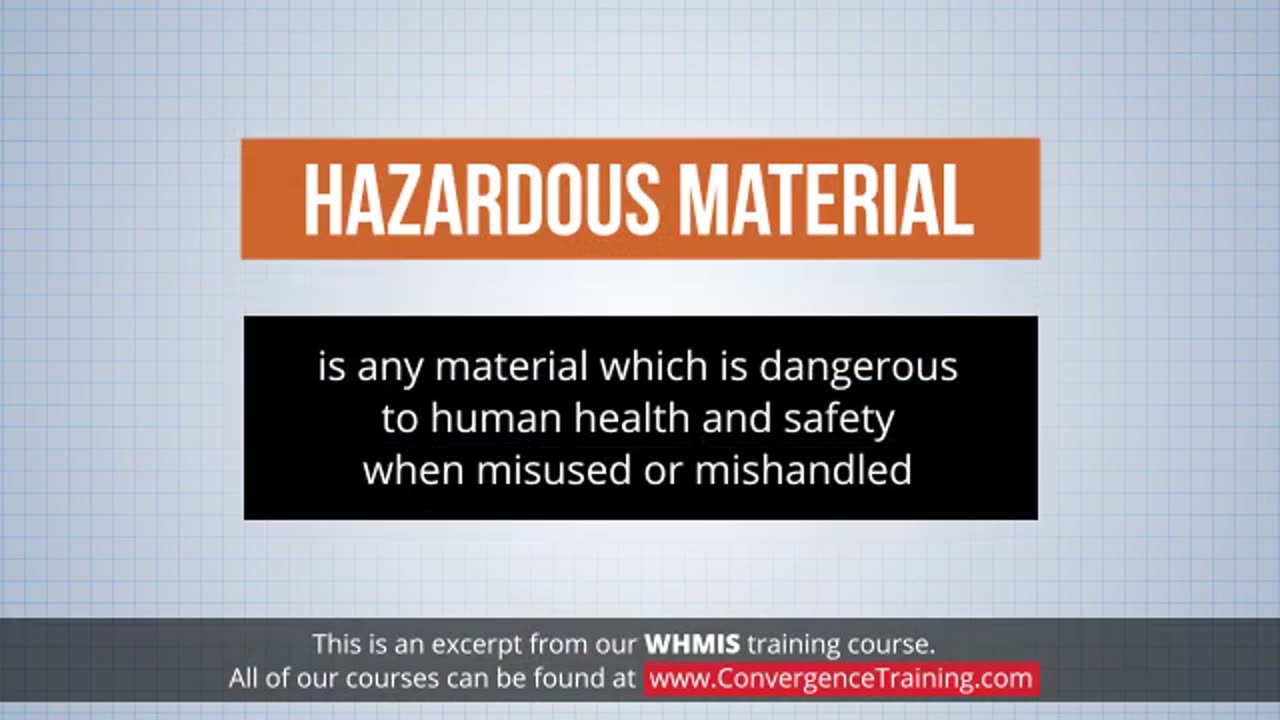Premium Only Content

Workplace Hazardous Materials Information System (WHMIS) Training
### **Workplace Hazardous Materials Information System (WHMIS) Training**
**WHMIS** is Canada’s national **hazard communication system** for providing information on hazardous materials used in workplaces. It ensures the **safe use, handling, and storage** of hazardous products to protect workers.
---
### **Purpose of WHMIS Training**
- To help workers identify **hazardous materials**.
- To teach proper **safety procedures** when working with or near hazardous products.
- To comply with Canada’s **occupational health and safety regulations**.
---
### **Key Components of WHMIS**
1. **Hazard Classes and Categories**:
Hazardous products are classified into two main groups:
- **Physical Hazards**: Flammable, explosive, or reactive materials.
- **Health Hazards**: Materials that can cause health issues (e.g., toxic, carcinogenic, corrosive).
2. **Labels**:
WHMIS requires two types of labels:
- **Supplier Labels**: Provided by the manufacturer. Includes:
- Product identifier (name).
- Hazard pictograms.
- Signal words (“Danger” or “Warning”).
- Hazard statements and precautionary statements.
- First aid and supplier information.
- **Workplace Labels**: For products transferred to secondary containers. Includes:
- Product name.
- Safe handling precautions.
- Reference to Safety Data Sheets (SDS).
3. **Safety Data Sheets (SDS)**:
- Detailed documents that provide information about hazardous products.
- Contains **16 standardized sections**, including:
- Product identification
- Hazards identification
- First aid measures
- Handling and storage guidelines
- Disposal considerations
4. **Worker Training and Education**:
Employers are required to:
- Educate workers about WHMIS.
- Train employees on **safe handling** procedures for specific hazardous products in the workplace.
---
### **Key Hazard Pictograms in WHMIS**
WHMIS uses **pictograms** to visually identify hazard types. Each pictogram has a specific symbol within a **red diamond** border:
| **Pictogram** | **Meaning** | **Example** |
|-----------------------------|-----------------------------------|------------------------|
| 🔥 **Flame** | Flammable materials | Gasoline, propane |
| 💣 **Exploding Bomb** | Explosives, reactive substances | Fireworks |
| ☠ **Skull and Crossbones** | Toxic (fatal or harmful) | Pesticides, cyanide |
| ⚛ **Health Hazard** | Long-term health effects | Carcinogens, asbestos |
| 🧪 **Corrosion** | Corrosive to skin or metals | Bleach, acids |
| ❗ **Exclamation Mark** | Less severe health effects | Irritants, allergens |
| 🔬 **Biohazardous** | Infectious materials | Bloodborne pathogens |
| 🏭 **Gas Cylinder** | Compressed gas | Oxygen tanks |
| 🌍 **Environment** | Environmental hazards | Oil, heavy metals |
---
### **WHMIS Training Requirements**
Employers must ensure that:
1. Workers are trained on **how to read labels** and **Safety Data Sheets (SDS)**.
2. Employees understand the **hazards** associated with materials they use.
3. Workers know how to:
- Store hazardous products safely.
- Use proper **Personal Protective Equipment (PPE)**.
- Respond to emergencies (e.g., spills, fires, exposures).
---
### **Responsibilities Under WHMIS**
- **Employers**:
- Provide WHMIS training.
- Ensure all hazardous products are properly labeled.
- Maintain up-to-date Safety Data Sheets (SDS).
- **Workers**:
- Participate in WHMIS training.
- Follow safe handling and storage procedures.
- Use PPE as required.
- Report hazards to supervisors.
- **Suppliers**:
- Classify hazardous products.
- Provide supplier labels and SDS for all products sold.
---
### **Emergency Response for Hazardous Materials**
If exposed to or handling a spill of hazardous materials:
1. **Alert** others and evacuate the area, if necessary.
2. **Refer to the SDS** for specific first aid and cleanup instructions.
3. Wear appropriate **PPE** before cleanup.
4. Report the incident to your supervisor immediately.
---
### **Benefits of WHMIS Training**
- Reduces workplace injuries and illnesses.
- Improves employee confidence in handling hazardous materials safely.
- Ensures regulatory compliance.
Would you like assistance creating **WHMIS training materials**, a quiz, or an **emergency response checklist**? Let me know!
-
 3:14:33
3:14:33
Joe Donuts Gaming
4 hours ago🟢 Live : Christmas is Here!! | Fortnite, Caroling, Light Tours and Donos !!
17K6 -
 LIVE
LIVE
CLUJ
3 hours agoCHRISTMAS EVENING HYPE!! LETS HAVE FUN GAMING!!
778 watching -
![I AM FINALLY BACK :: PUBG: BATTLEGROUNDS :: RUMBLE NOW HAS GIFTED SUBS!!! [Merry Christmas] {18+}](https://1a-1791.com/video/fwe1/22/s8/1/e/f/C/6/efC6v.0kob-small-I-AM-FINALLY-BACK-PUBG-BATT.jpg) LIVE
LIVE
a12cat34dog
5 hours agoI AM FINALLY BACK :: PUBG: BATTLEGROUNDS :: RUMBLE NOW HAS GIFTED SUBS!!! [Merry Christmas] {18+}
151 watching -
 3:55:42
3:55:42
STARM1X16
5 hours agoMerry Christmas Fortnite
22.7K2 -
 2:45:33
2:45:33
Sgtfinesse
5 hours agoMerry Christmas Night
30.5K6 -
 LIVE
LIVE
tacetmort3m
21 hours ago🔴 LIVE - (MERRY CHRISTMAS) TIME TO SPREAD DEMOCRACY - HELLDIVERS 2 OMENS OF TYRANNY
76 watching -
 12:42
12:42
Cooking with Gruel
19 hours agoBrown Butter Trifle with Salted Caramel and Cinnamon Apple
10.1K3 -
 2:46
2:46
BIG NEM
8 hours agoDiscovering RAKIJA: The Holy Liquer of the Balkans
8.05K2 -
 1:11:38
1:11:38
Film Threat
13 hours agoCHRISTMAS DAY CHILL STREAM WITH CHRIS GORE | Hollywood on the Rocks
131K24 -
 14:22:40
14:22:40
The Quartering
1 day agoYule Log Christmas MAGA Edition With Memes! Come Hang Out!
221K29